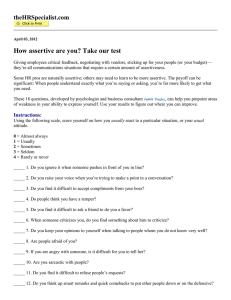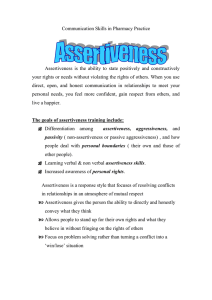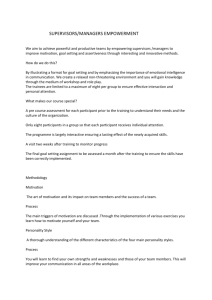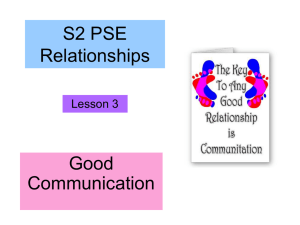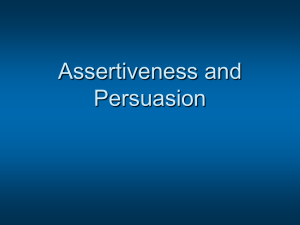Assertiveness
advertisement
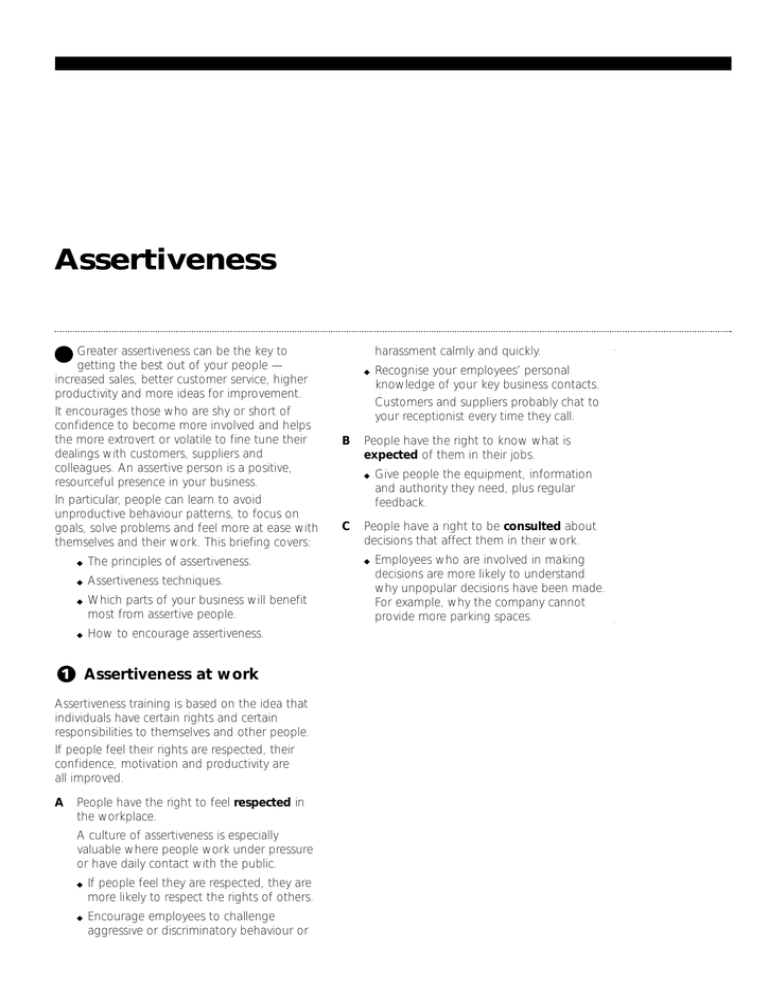
Assertiveness Greater assertiveness can be the key to getting the best out of your people — increased sales, better customer service, higher productivity and more ideas for improvement. It encourages those who are shy or short of confidence to become more involved and helps the more extrovert or volatile to fine tune their dealings with customers, suppliers and colleagues. An assertive person is a positive, resourceful presence in your business. In particular, people can learn to avoid unproductive behaviour patterns, to focus on goals, solve problems and feel more at ease with themselves and their work. This briefing covers: ◆ The principles of assertiveness. ◆ Assertiveness techniques. ◆ Which parts of your business will benefit most from assertive people. ◆ How to encourage assertiveness. Assertiveness at work Assertiveness training is based on the idea that individuals have certain rights and certain responsibilities to themselves and other people. If people feel their rights are respected, their confidence, motivation and productivity are all improved. A People have the right to feel respected in the workplace. A culture of assertiveness is especially valuable where people work under pressure or have daily contact with the public. ◆ If people feel they are respected, they are more likely to respect the rights of others. ◆ Encourage employees to challenge aggressive or discriminatory behaviour or harassment calmly and quickly. ◆ B People have the right to know what is expected of them in their jobs. ◆ C Recognise your employees’ personal knowledge of your key business contacts. Customers and suppliers probably chat to your receptionist every time they call. Give people the equipment, information and authority they need, plus regular feedback. People have a right to be consulted about decisions that affect them in their work. ◆ Employees who are involved in making decisions are more likely to understand why unpopular decisions have been made. For example, why the company cannot provide more parking spaces. D People have a right to make genuine mistakes and do not deserve blame and put-downs. E ◆ Many mistakes occur because people have not been properly trained or equipped. ◆ A culture of blame has a negative impact on morale. People cover their backs or accuse others, rather than accept responsibility for their actions. People have the responsibility to respect other people’s rights, irrespective of seniority. A State specifically and simply what you feel and what you want to happen. B ◆ Begin your sentences in the first person. For example, ‘I feel frustrated when what I say is ignored in meetings.’ ◆ Make brief, to-the-point statements. For example, ‘I would like, at least, to be acknowledged when I offer an idea.’ Speak directly, without hinting, beating about the bush, flattering, flirting or manipulating to get what you want. ◆ The assertive approach Assertive people have a positive, open style of communication, neither submissive nor aggressive. They adopt a meeting-as-equals, ‘win-win’ approach to work relations. The basic techniques for behaving assertively can be easily learned and put into practice quickly. C Do not speak apologetically, or aggressively. The opinions and needs you express risk being ignored if you do. Stand your ground if what you are saying or doing is valid. ◆ Do not let other people’s vehemence or apparent certainty make you think you must be wrong. D Stay calm and do not give in to anger. Taking out your aggression or frustration on others does you no good and can lead to careless actions or unsafe working. Breaking the patterns There are three common types of counterproductive behaviour pattern that occur in almost every workplace. All three can be addressed with basic assertiveness training. A Aggressive behaviour rarely goes unnoticed, as it tends to be noisy and calls attention to itself. ◆ B Express your valid feelings and requirements clearly and in good time, rather than bottling things up until you explode. ◆ Allow time to elapse (count to ten) after an initial angry response, before expressing the reasons for it to others. Be prepared to walk away until you feel calmer and more in control. ◆ Bear in mind that other people, or their actions, cannot actually ‘make’ you angry. If you react with anger, it is because you choose to surrender control and let yourself react this way. ◆ Do not allow your body language to become aggressive. Avoid pointing at people, raising your voice, banging the table or making other aggressive gestures. Submissive behaviour does not usually upset other people. ◆ C People — and whole groups — may be steamrollered into accepting second-rate standards or ideas. ◆ The only individual who suffers directly is the submissive person, but the entire business may lose if that person’s thoughts and ideas go unheard. Aggressive/submissive behaviour is a pattern that can be highly disruptive. The person may swing between extremes as his or her moods change, or may have a fixed pattern. For example, aggressive towards less senior employees, but submissive in the company of managers. ◆ These behaviour patterns make it hard to predict the person’s reactions and can leave others uncertain about how to act. In a workplace where calmly assertive behaviour is seen as the norm, people focus on the job and productivity rises. More people contribute ideas and input and more become actively involved in running the business. E Be prepared to say no or ‘agree to disagree’. ◆ Everyone at work is entitled to refuse unreasonable requests (see 5). Giving feedback For a manager, giving and receiving feedback are key aspects of assertive behaviour in the workplace. You can expect feedback sessions with people who have had assertiveness training to be particularly frank and issues-based. A Discuss poor performance in a constructive spirit, in private. page 2 B ◆ When giving feedback, know what positive outcome you want to achieve. ◆ Make suggestions about alternatives, but let the other person identify what action to take. Avoid telling the other person what to do. ◆ Be clear about your motive. If it is simply to vent your own feelings, do not do it. When discussing a problem, talk about the facts of the case. ◆ ◆ ◆ C instructions or failed to provide what was needed to do the job. Both parties should avoid personal comments. Sentences beginning ‘You are…’ are seldom helpful. ◆ Ask ‘How do you see this?’ or ‘Is that a fair description?’ to get the employee’s version of events. ◆ Keep asking until you get a response. If at first you get no reaction, be patient. Do not accept silence as meaning the other person has nothing to say. ◆ Respect the other person’s feelings and be sensitive to the response to your feedback. D Listen calmly to the other person and show you understand what is being said. Your aim should be to correct the fault, not criticise the person. Be direct and specific and avoid exaggeration. Do say ‘There were faults in the accounts sheets in columns two, three and ten.’ Do not say ‘The accounts were full of faults.’ Give credit for the person’s achievements. ◆ Give the person time to formulate an answer. Be patient. Do not rush people or answer for them. ◆ Help shy people by asking questions they can answer easily and guiding them gently towards stating their views. ◆ If you don’t understand an answer, ask more questions to clarify. Do not jump to conclusions or make assumptions. Share your interpretation of the facts. The circumstances surrounding poor performance may have been misunderstood. ◆ E Encourage the employee to respond to your description of the facts. Make it clear that you are listening. For example, a task may be unfinished because a manager gave inadequate Making a difference ◆ F Introducing assertiveness training can often solve specific problems, as well as enhancing overall business performance. A In areas such as credit control, employees become more capable of handling difficult situations without inflaming them. B Employees become better at protecting the business from unreasonable demands. C Secretaries and clerical employees, who may have been inhibited about voicing their opinions, start to offer suggestions to improve efficiency in the office. D If parts of the business suffer from low morale or absenteeism, assertiveness training may provide a practical solution. ◆ Managers and employees in these areas can be taught how to deal with problems openly and honestly. With less friction and fewer bottled-up tensions, a more productive atmosphere can be created and employees can realise more of their potential. See Personal development plans, HR 29. Offer and accept apologies, ungrudgingly, if they are appropriate. Poor performance will not improve if there is ill-will between manager and employee. Positive expectations on one side and determination to do better on the other are needed. Summarise what has been said and agreed. Clarify that there are no further obstacles to good performance. Receiving feedback Regardless of the position held in the company, feedback must be direct and honest to be productive. Exchanging feedback can be especially valuable for senior managers in a business where assertiveness is established and welcomed. A When receiving feedback on poor performance, separate your natural dislike of being criticised from the valid points being made about your behaviour. B When receiving criticism, do not make excuses that will not stand up to scrutiny. . C If an unfair general accusation is being levelled at you, ask for specific examples. D Accept praise and be prepared to learn from it as well. page 3 Requests A If someone is angry, identify the cause of the anger and take steps to deal with it. A When making a request in the workplace, be honest about what is involved. B ◆ Do not pretend a two-hour job will take ten minutes. ◆ Do not apologise for asking. Faced with an unreasonable request from a customer or colleague, explain why you cannot comply, and suggest an alternative. ◆ ◆ ◆ The customer is not always right. But the customer always has the right to an explanation. C If someone is being personally offensive, end the conversation quickly and firmly. ◆ Ask ‘Can you put that another way?’ or ‘Have I got this right?’ (followed by a summary of what you think was said). Assertive behaviour must be welcomed in your business, if each person is to operate assertively. A Provide assertiveness training for sales people, receptionists and customer service people first, and other employees later. ◆ B Reinforce a win-win culture in the business. If the customer is angry, begin your response with ‘I’m sorry you feel our product hasn’t met your expectations.’ This wording lets you express sympathy with his or her disappointment, without conceding that the product is faulty. ◆ Train your supervisors and managers to encourage plain speaking and support assertive behaviour. ◆ Do not tolerate bullies in the workplace. ◆ Assertiveness training for your thrusting go-getters may be better aimed at learning how to listen than how to get heard. D Never blame your colleagues, the customer or your suppliers. E Reconstruct, with the customer’s help, the steps which led to the complaint. You may find there is more than one factor behind it. ◆ For example, a service issue, as well as a product problem. C Provide multiple communication channels. ◆ Call regular team and department meetings and encourage everyone to participate in the discussions. ◆ Introduce newsletters, team bulletins and individual or group contributions to your intranet, if you have one. Every chance to express themselves boosts employees’ confidence and sense of worth. ◆ In your appraisal process, ask questions that will encourage employees to express their needs and viewpoints. (See Performance appraisals, HR 10.) This step-by-step ‘diary’ will help you get it right in future, and most customers respond well to the professionalism of this approach. Angry people Dealing with angry people — customers or colleagues — is a matter of damage limitation. Be assertive and actively manage the situation. Include supervisors and managers. They need to understand the pressures their teams face and learn to deal with them. A workplace where people see all transactions in terms of winners and losers reinforces unproductive behaviour patterns. Defuse the situation by acknowledging the other person’s point of view. ◆ Take time away from the situation to consider your longer-term response. A culture of assertiveness Do not be afraid to request clarification — if necessary, more than once. ◆ C If people are clearly out of control, do not attempt to deal with them. Let them know that communication must wait until later. Do not say ‘maybe’, if you mean ‘no’. A Show a customer with a complaint that you have heard and are making the effort to understand the point that is being made. For example, with an angry customer, do not waste time making excuses. Accept the criticism, apologise and say what you will do to deal with the complaint. Take some immediate action, and be seen to be doing so, even if it is only noting the customer’s name and address. B Employees also deserve explanations. They need to know why business needs may override personal feelings, and the reasons behind decisions that affect their work. Handling complaints B ◆ page 4

